 W
WThe Alfred Jewel is a piece of Anglo-Saxon goldsmithing work made of enamel and quartz enclosed in gold. It was discovered in 1693, in North Petherton, Somerset, England and is now one of the most popular exhibits at the Ashmolean Museum in Oxford. It has been dated to the late 9th century, in the reign of Alfred the Great and is inscribed "AELFRED MEC HEHT GEWYRCAN", meaning "Alfred ordered me made". The jewel was once attached to a rod, probably of wood, at its base. After decades of scholarly discussion, it is now "generally accepted" that the jewel's function was to be the handle for a pointer stick for following words when reading a book. It is an exceptional and unusual example of Anglo-Saxon jewellery.
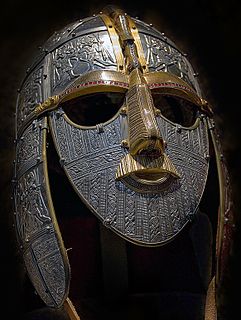 W
WAnglo-Saxon glass has been found across England during archaeological excavations of both settlement and cemetery sites. Glass in the Anglo-Saxon period was used in the manufacture of a range of objects including vessels, beads, windows and was even used in jewellery. In the 5th century AD with the Roman departure from Britain, there were also considerable changes in the usage of glass. Excavation of Romano-British sites have revealed plentiful amounts of glass but, in contrast, the amount recovered from 5th century and later Anglo-Saxon sites is minuscule.
 W
WThe Bedale Hoard is a hoard of forty-eight silver and gold items dating from the late 9th to early 10th century AD and includes necklaces, arm-bands, a sword pommel, hacksilver and ingots. It was discovered on 22 May 2012 in a field near Bedale, North Yorkshire by metal detectorists, and reported via the Portable Antiquities Scheme. Following a successful public funding campaign, the hoard was acquired by the Yorkshire Museum for £50,000.
 W
WThe Benty Grange hanging bowl is a fragmentary Anglo-Saxon artefact from the 7th century AD. All that remains are two escutcheons; a third disintegrated soon after excavation, and no longer survives. The escutcheons were found in 1848, alongside the better-known Benty Grange helmet, by the antiquary Thomas Bateman in a tumulus at the Benty Grange farm in Derbyshire. They were undoubtedly buried as part of an entire hanging bowl, placed in what appears to have been the burial mound of a high-status warrior.
 W
WThe Benty Grange helmet is a boar-crested Anglo-Saxon helmet from the 7th century AD. It was excavated by Thomas Bateman in 1848 from a tumulus at the Benty Grange farm in Monyash in western Derbyshire. The grave had probably been looted by the time of Bateman's excavation, but still contained other high-status objects suggestive of a richly furnished burial, such as the fragmentary remains of a hanging bowl. The helmet is displayed at Sheffield's Weston Park Museum, which purchased it from Bateman's estate in 1893.
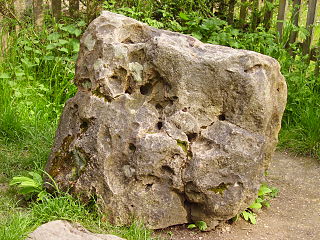 W
WThe Blowing Stone is a perforated sarsen at grid reference SU32412 87083 in Kingston Lisle, Oxfordshire. The stone is in a garden at the foot of Blowingstone Hill just south of the Icknield Way (B4507), about 4 1⁄2 miles (7 km) west of Wantage and about 1 1⁄2 miles (2.4 km) east of White Horse Hill.
 W
WThe Coppergate Helmet is an eighth-century Anglo-Saxon helmet found in York, England. It was discovered in May 1982 during excavations for the Jorvik Viking Centre at the bottom of a pit that is thought to have once been a well.
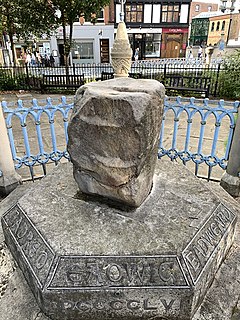 W
WThe Coronation Stone is an ancient sarsen stone block which is believed to have been the site of the coronation of seven Anglo-Saxon kings. It is presently located next to the Guildhall in Kingston upon Thames, England. Kingston is now a town in the Royal Borough of Kingston Upon Thames in Greater London, but remains the seat of the administration of the county of Surrey.
 W
WThe Crowle Stone is the remains of an Anglo-Saxon cross at the back of the Church of England parish church of St Oswald at Crowle, Lincolnshire.
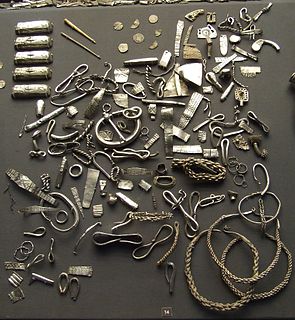 W
WThe Cuerdale Hoard is a hoard of more than 8,600 items, including silver coins, English and Carolingian jewellery, hacksilver and ingots. It was discovered on 15 May 1840 on the southern bank of a bend of the River Ribble, in an area called Cuerdale near Preston, Lancashire, England. The Cuerdale Hoard is one of the largest Viking silver hoards ever found, four times larger than its nearest rival in Britain or Ireland, according to Richard Hall. In weight and number of pieces, it is second only to the Spillings Hoard found on Gotland, Sweden.
 W
WThe Escrick ring is a gold finger ring set with a large blue gemstone and red glass cloisonné dating to the 5th to 6th century AD. It was discovered on 22 May 2009 in a field near Escrick, North Yorkshire by a metal detectorist and reported via the Portable Antiquities Scheme. Following a successful funding campaign, the hoard was acquired by the Yorkshire Museum for £35,000.
 W
WThe Forsbrook Pendant is a piece of Anglo Saxon jewellery found in Forsbrook, Staffordshire, England and sold to the British Museum in 1879. It is a 7th-century setting of a 4th-century gold Roman coin in gold cellwork with garnet and blue glass inlays.
 W
WThe Guilden Morden boar is a sixth- or seventh-century Anglo-Saxon copper alloy figure of a boar that may have once served as the crest of a helmet. It was found around 1864 or 1865 in a grave in Guilden Morden, a village in the eastern English county of Cambridgeshire. There the boar attended a skeleton with other objects, including a small earthenware bead with an incised pattern, although the boar is all that now remains. Herbert George Fordham, whose father originally discovered the boar, donated it to the British Museum in 1904; as of 2018 it was on view in room 41.
 W
WHanging bowls are a distinctive type of artifact of the period between the end of Roman rule in Britain in c. 410 AD and the emergence of the Christian Anglo-Saxon kingdoms during the 7th century. The surviving examples have mostly been found in Anglo-Saxon graves, but there is general agreement that they reflect Celtic traditions of decoration.
 W
WThe Horncastle boar's head is an early seventh-century Anglo-Saxon ornament depicting a boar that probably was once part of the crest of a helmet. It was discovered in 2002 by a metal detectorist searching in the town of Horncastle, Lincolnshire. It was reported as found treasure and acquired for £15,000 by the City and County Museum, where it is on permanent display.
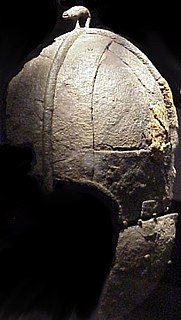 W
WThe Pioneer Helmet is a boar-crested Anglo-Saxon helmet from the late seventh century found in Wollaston, Northamptonshire, United Kingdom. It was discovered during a March 1997 excavation before the land was to be mined for gravel and was part of the grave of a young man. Other objects in the grave, such as a hanging bowl and a pattern welded sword, suggest that it was the burial mound of a high-status warrior.
 W
WThe Prittlewell royal Anglo-Saxon burial or Prittlewell princely burial is a high-status Anglo-Saxon burial mound which was excavated at Prittlewell, north of Southend-on-Sea, in the English county of Essex.
 W
WA sceat was a small, thick silver coin minted in England, Frisia and Jutland during the Anglo-Saxon period.
 W
WThe Seax of Beagnoth is a 10th-century Anglo-Saxon seax. It was found in the River Thames in 1857, and is now at the British Museum in London. It is a prestige weapon, decorated with elaborate patterns of inlaid copper, brass and silver wire. On one side of the blade is the only known complete inscription of the twenty-eight letter Anglo-Saxon runic alphabet, as well as the name "Beagnoth" in runic letters. It is thought that the runic alphabet had a magical function, and that the name Beagnoth is that of either the owner of the weapon or the smith who forged it. Although many Anglo-Saxon and Viking swords and knives have inscriptions in the Latin alphabet on their blades, or have runic inscriptions on the hilt or scabbard, the Seax of Beagnoth is one of only a handful of finds with a runic inscription on its blade.
 W
WThe Shorwell helmet is an Anglo-Saxon helmet from the early to mid-sixth century AD found near Shorwell on the Isle of Wight in southern England. It was one of the grave goods of a high-status Anglo-Saxon warrior, and was found with other objects such as a pattern-welded sword and hanging bowl. One of only six known Anglo-Saxon helmets, alongside those from Benty Grange, Sutton Hoo, Coppergate, Wollaston, and Staffordshire, it is the sole example to derive from the continental Frankish style rather than the contemporaneous Northern "crested helmets" used in England and Scandinavia.
 W
WThe Staffordshire Hoard is the largest hoard of Anglo-Saxon gold and silver metalwork yet found. It consists of over 3,500 items, amounting to a total of 5.1 kg (11 lb) of gold, 1.4 kg (3 lb) of silver and some 3,500 pieces of garnet cloisonné jewellery.
 W
WStamford ware is a type of lead-glazed earthenware, one of the earliest forms of glazed ceramics manufactured in England. It was produced in Stamford, Lincolnshire between the ninth and thirteenth centuries. It was widely traded across Britain and the near continent. The most popular forms were jugs, spouted pitchers, and small bowls. Distribution of Stamford ware has been used to map trade routes of the period.
 W
WThe Sutton Hoo purse-lid is one of the major objects excavated from the Anglo-Saxon royal burial-ground at Sutton Hoo in Suffolk, England. The site contains a collection of burial mounds, of which much the most significant is the undisturbed ship burial in Mound 1 containing very rich grave goods including the purse-lid. The person buried in Mound 1 is usually thought to have been Raedwald, King of East Anglia, who died around 624. The purse-lid is considered to be "one of the most remarkable creations of the early medieval period." About seven and a half inches long, it is decorated with beautiful ornament in gold and garnet cloisonné enamel, and was undoubtedly a symbol of great wealth and status. In 2017 the purse-lid was on display at the British Museum.
 W
WThe Uttoxeter Casket, also known as Philip Nelson's Casket, is an Anglo Saxon reliquary from Uttoxeter, Staffordshire in the United Kingdom. As of 2017, it is held at the Cleveland Museum of Art in Ohio, USA. House-shaped and carved from a single piece of boxwood, it remains the only known surviving wood carving with such an elaborate iconographic programme from this period of British history.